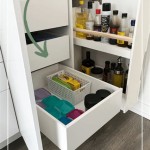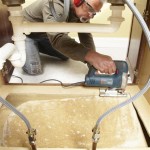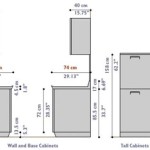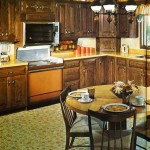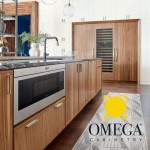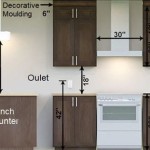Flat Panel Wood Kitchen Cabinets: A Sleek and Versatile Choice
Flat panel wood kitchen cabinets represent a contemporary design aesthetic that emphasizes clean lines, simplicity, and functionality. Unlike raised panel or ornate cabinet styles, flat panel cabinets, also known as slab cabinets, feature a smooth, unadorned surface. This design choice contributes to a minimalist look that integrates seamlessly into a variety of kitchen styles, from modern and Scandinavian to transitional and even some traditional settings.
The popularity of flat panel cabinets stems from their versatility and ability to create a sense of spaciousness within a kitchen. Their streamlined appearance reduces visual clutter, making smaller kitchens appear larger and more open. Moreover, the absence of intricate details simplifies cleaning and maintenance, a significant advantage for busy homeowners. The material of choice, wood, adds warmth and natural beauty to the overall design, contrasting with the often starkness of purely minimalist spaces.
Choosing the right wood species, finish, and hardware are crucial considerations when selecting flat panel wood kitchen cabinets. These elements significantly impact the cabinet's overall aesthetic and durability, as well as how well they complement the existing or planned kitchen design. Understanding the properties of different wood types and the advantages of various finishing techniques is essential for making informed decisions.
Wood Species Selection: Aesthetic and Durability Considerations
The choice of wood species is paramount when selecting flat panel wood kitchen cabinets. Different wood types offer varying degrees of durability, grain patterns, and natural color variations, all of which contribute to the cabinet's unique aesthetic. Some popular wood species for flat panel cabinets include:
Maple: Maple is a hardwood known for its smooth, fine grain and light color. It readily accepts stains and paints, making it a versatile option for achieving a wide range of looks. Maple is also a relatively durable wood, resistant to dents and scratches, making it suitable for high-traffic kitchens.
Oak: Oak is a classic choice for kitchen cabinets, prized for its distinctive grain pattern and robust durability. Red oak and white oak are the two primary varieties, each with slightly different color tones and grain characteristics. Oak is a strong and durable wood that can withstand daily wear and tear. Its prominent grain pattern can add visual interest to flat panel cabinets, although this might not align with the minimalist aesthetic some designers seek.
Cherry: Cherry wood is renowned for its rich, warm color and smooth grain. It darkens naturally over time, developing a deeper, more lustrous patina. Cherry is a moderately durable wood that requires some care to prevent scratches and dents. Its inherent beauty makes it a popular choice for homeowners seeking a sophisticated and elegant kitchen.
Walnut: Walnut is a premium hardwood valued for its dark, chocolate-brown color and striking grain patterns. It is a durable wood that offers a luxurious and refined look. Walnut flat panel cabinets can create a dramatic focal point in a kitchen, but their higher cost makes them a more expensive option.
Hickory: Hickory is one of the hardest and most durable domestic hardwoods. It features a bold grain pattern and a range of color variations, from creamy white to dark brown. Hickory is an excellent choice for kitchens that require exceptional durability and resistance to wear and tear. However, its strong grain pattern might not appeal to those seeking a very clean and minimalist aesthetic.
Other options: Other wood species that are occasionally used for flat panel cabinets include birch, alder, and even certain engineered wood products like plywood with wood veneers. These options can offer cost savings or specific aesthetic characteristics.
The selection of wood species should be based on a balance of aesthetic preferences, durability requirements, and budget considerations. Samples of different wood types should be examined under varying lighting conditions to accurately assess their color and grain patterns.
Finishes and Hardware: Enhancing the Cabinet's Style and Functionality
The finish applied to flat panel wood kitchen cabinets plays a crucial role in their appearance and protection. Different finishing techniques can enhance the natural beauty of the wood, alter its color, and provide a protective barrier against moisture, stains, and scratches. Common finishing options include:
Staining: Staining involves applying a colored liquid to the wood to penetrate the surface and enhance the grain pattern. Stains are available in a wide range of colors, from light and natural tones to dark and dramatic hues. Staining allows the natural wood grain to remain visible, adding depth and character to the cabinets.
Painting: Painting involves applying a solid color to the wood surface, completely concealing the grain pattern. Paint provides a more uniform and modern look, and it can be easily customized to match any color scheme. High-quality cabinet-grade paints are essential for achieving a durable and long-lasting finish.
Sealing: Sealing involves applying a clear coat to the wood surface to protect it from moisture and wear. Sealers can be matte, satin, or glossy, depending on the desired level of sheen. Sealing is often used in conjunction with staining or painting to provide an additional layer of protection.
Varnishing/Lacquering: These finishes provide a durable, water-resistant coating. They are generally more resistant to scratches and chemicals than simpler sealers. They can be applied in varying sheens from matte to high gloss.
The choice of finish should be based on the desired aesthetic and the level of protection required. Lighter finishes can brighten up a kitchen and create a more open feel, while darker finishes can add warmth and sophistication. A durable finish is essential for ensuring that the cabinets can withstand the rigors of daily use.
Hardware selection is another critical aspect of flat panel cabinet design. The handles, knobs, and pulls chosen for the cabinets can significantly impact their overall style and functionality. For a minimalist look, consider using sleek, understated hardware in brushed nickel, stainless steel, or matte black. Alternatively, you can opt for handle-less cabinets with integrated pulls or push-to-open mechanisms.
The hardware should be both aesthetically pleasing and ergonomic. It should be comfortable to grip and easy to use, even with wet or greasy hands. The size and placement of the hardware should also be carefully considered to ensure proper functionality and visual balance.
Properly chosen finishes and thoughtfully selected hardware elevate both the aesthetic appeal and the practical functionality of flat panel cabinets.
Integrating Flat Panel Cabinets into Different Kitchen Styles
Flat panel wood kitchen cabinets are incredibly versatile and can be seamlessly integrated into a variety of kitchen styles. Their clean lines and minimalist design make them a perfect fit for modern and contemporary kitchens, but they can also be adapted to suit transitional and even some traditional settings.
Modern Kitchens: In modern kitchens, flat panel cabinets are often paired with sleek countertops, stainless steel appliances, and minimalist hardware. The cabinets are typically finished in a neutral color, such as white, gray, or black, to create a clean and sophisticated look. Backsplashes featuring geometric tile patterns and open shelving can further enhance the modern aesthetic.
Scandinavian Kitchens: Scandinavian kitchens emphasize natural light, light wood tones, and functional design. Flat panel cabinets in light maple or birch are a natural fit for this style. The cabinets are often paired with white countertops and simple hardware. Natural textures, such as wood flooring and woven rugs, add warmth and comfort to the space.
Transitional Kitchens: Transitional kitchens blend traditional and modern elements to create a timeless and elegant look. Flat panel cabinets can be incorporated into transitional kitchens by pairing them with classic countertops, such as granite or marble, and traditional hardware. A neutral color palette with pops of color can add visual interest to the space.
Traditional Kitchens: While flat panel cabinets might not be the first choice for a traditionally styled kitchen, it's possible to integrate them creatively. Opting for darker wood tones like cherry or walnut and pairing them with more ornate hardware can bridge the gap. Choosing a traditional countertop material and incorporating architectural details like crown molding can also help blend the modern cabinet style with a traditional design. Textural details, like a beadboard backsplash, can also soften the modern lines of the flat panel.
The key to integrating flat panel cabinets into any kitchen style is to carefully consider the surrounding elements and choose finishes and hardware that complement the overall design. By paying attention to the details, it's possible to create a cohesive and visually appealing kitchen that reflects personal style.
Ultimately, the selection of flat panel wood kitchen cabinets involves navigating a complex interplay between material, finish, hardware, and overall design considerations. A careful assessment of these elements is crucial for achieving a kitchen space that is both aesthetically pleasing and functionally sound.

Top 9 Hardware Styles For Flat Panel Kitchen Cabinets

53 Flat Panel Kitchen Cabinets With Pros And Cons Digsdigs

Image Result For Flat Panel Kitchen Cabinet Doors Front Cabinets Door Styles New

Flat Panel White Oak Cabinet Kitchen The Cabinets Feature A Clea Modern Design Layout

50 Timeless Flat Panel Kitchen Cabinet Ideas Shelterness

Contemporary By Rg Design Studio Inc White Oak Kitchen Modern Maple Interior

Flat Panel Cabinets In Kitchen Find The Advantages Of Slab

Walnut Flat Panel Kitchen Cabinetry Bay Area Berkeley Mills

52 Natural Wood Kitchen Cabinets Look

Flat Panel Kitchen Cabinet Ideas And Inspiration Hunker
Related Posts

